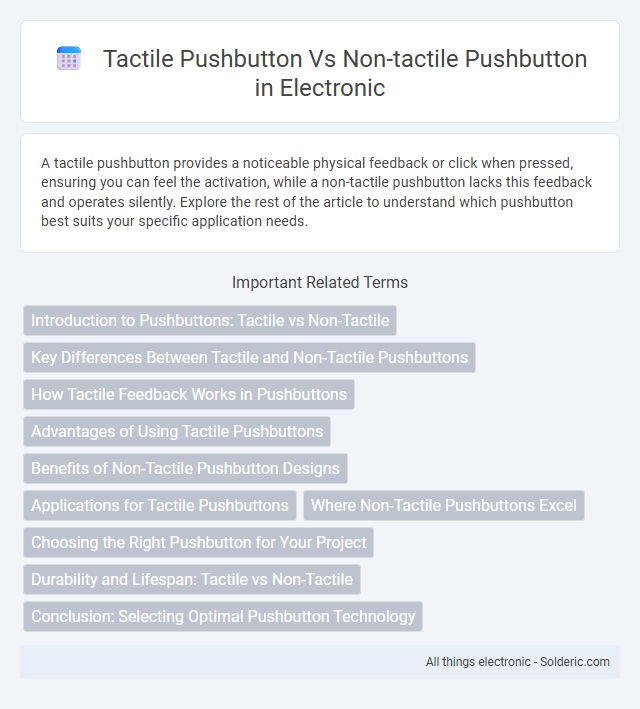A tactile pushbutton provides a noticeable physical feedback or click when pressed, ensuring you can feel the activation, while a non-tactile pushbutton lacks this feedback and operates silently. Explore the rest of the article to understand which pushbutton best suits your specific application needs.
Comparison Table
| Feature | Tactile Pushbutton | Non-Tactile Pushbutton |
|---|---|---|
| Feedback | Provides tactile (click) feedback | No tactile feedback, smooth press |
| Operation | Momentary switch with distinct actuation point | Momentary switch, usually soft touch |
| Applications | Keyboards, control panels, devices needing confirmation | Touch interfaces, simple on/off controls |
| Durability | Typically high, designed for repeated use | Varies, often lower due to no mechanical feedback |
| Cost | Moderate, slightly higher due to feedback mechanism | Usually lower, simpler construction |
| Size | Compact, standard sizes available | Variable sizes, often smaller or slim |
Introduction to Pushbuttons: Tactile vs Non-Tactile
Tactile pushbuttons provide a physical click or feedback when pressed, enabling precise user input detection, ideal for applications requiring confirmation of activation. Non-tactile pushbuttons lack this mechanical feedback, resulting in a smooth, silent press that suits minimalist designs or touch-sensitive interfaces. The choice between tactile and non-tactile pushbuttons depends on user experience needs, device functionality, and the importance of sensory feedback in the application.
Key Differences Between Tactile and Non-Tactile Pushbuttons
Tactile pushbuttons provide a noticeable physical feedback or "click" when pressed, enhancing user interaction by confirming the input through touch. Non-tactile pushbuttons lack this feedback, offering smooth, silent operation that is ideal for applications requiring discreet or quiet inputs. Selecting between these pushbutton types depends on your need for tactile confirmation versus silent functionality in your electronic device.
How Tactile Feedback Works in Pushbuttons
Tactile feedback in pushbuttons is achieved through a small, mechanical bump or snap mechanism that provides a physical sensation when the button is pressed, indicating a successful input. This feedback relies on a metal dome or similar component beneath the button surface, which collapses and produces a distinct click or resistance that your finger can feel. Non-tactile pushbuttons lack this feature, often resulting in no physical indication of actuation, making tactile pushbuttons preferable for applications requiring precise and reliable user interaction.
Advantages of Using Tactile Pushbuttons
Tactile pushbuttons offer distinct advantages such as providing clear physical feedback through a noticeable click, which enhances user confidence and interaction accuracy. Their reliable actuation points reduce accidental presses and improve the overall user experience, especially in applications requiring precise control. Choosing tactile pushbuttons ensures better durability and responsiveness, making Your devices more intuitive and user-friendly.
Benefits of Non-Tactile Pushbutton Designs
Non-tactile pushbutton designs offer a smooth, silent operation, reducing noise in sensitive environments. Their low-profile construction enhances sleek device aesthetics and allows for compact, space-saving integration on printed circuit boards (PCBs). These pushbuttons typically provide higher durability with fewer mechanical parts, resulting in increased reliability and longer lifespan compared to tactile counterparts.
Applications for Tactile Pushbuttons
Tactile pushbuttons are widely used in consumer electronics, industrial control panels, and automotive dashboards due to their reliable click feedback and precise user input. Their distinct tactile response improves user experience in devices like keyboards, remote controls, and handheld gaming consoles. These pushbuttons are preferred in applications requiring confirmation of actuation without visual cues, enhancing operational accuracy.
Where Non-Tactile Pushbuttons Excel
Non-tactile pushbuttons excel in applications requiring silent operation and minimal tactile feedback, such as touchscreen overlays and membrane switches in consumer electronics. Their smooth, low-profile design allows seamless integration into compact devices where space and aesthetic are critical. You benefit from their durability and sleek user interface, making them ideal for environments where subtle activation is preferred.
Choosing the Right Pushbutton for Your Project
Choosing the right pushbutton for your project depends on the desired user experience and application requirements. Tactile pushbuttons provide a noticeable physical feedback or "click," ensuring precise input confirmation, while non-tactile pushbuttons offer a smooth, silent press ideal for minimalist designs. Your selection should consider factors like user interaction, durability, and environmental conditions to optimize device performance and reliability.
Durability and Lifespan: Tactile vs Non-Tactile
Tactile pushbuttons typically offer higher durability and a longer lifespan due to their robust internal spring mechanisms that provide consistent feedback over millions of cycles. Non-tactile pushbuttons, lacking this feedback mechanism, may wear out faster under heavy use as their contacts rely solely on simple resistance changes, which can degrade over time. Choosing a tactile pushbutton can ensure your device maintains reliable performance and longevity in demanding applications.
Conclusion: Selecting Optimal Pushbutton Technology
Tactile pushbuttons provide a distinct physical feedback, enhancing user confidence through a noticeable click, which is crucial for applications requiring precise control. Non-tactile pushbuttons, lacking this feedback, offer a smoother, quieter press suited for environments where noise reduction is important. Your choice should balance tactile responsiveness and operational quietness based on the specific needs of your device or user experience.
tactile pushbutton vs non-tactile pushbutton Infographic

 solderic.com
solderic.com